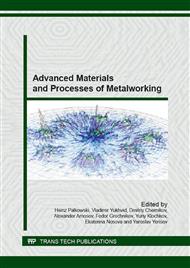[1]
Tönshoff, H.K., Bussmann, W., and Stanske, C., 1986, Requirements on Tools and Machines when Machining Hard Materials, Proc. of the 26th Int. Mach. ToolandRes. Conf. pp.349-357.
DOI: 10.1007/978-1-349-08114-1_45
Google Scholar
[2]
Khaimovich, А. Balaykin, A. Galkina, N. (2015) Study of Rheological Properties of Materials at the Blade Processing on Example of Milling Nickel-Chromium Alloy 10H11N23T3 MR VD, Applied Mechanics and Materials, vol. 756 (2015) pp.120-125.
DOI: 10.4028/www.scientific.net/amm.756.120
Google Scholar
[3]
Komissarov V. I., investigation of the machinability of titanium and heat-resistant materials in face milling. Kuibyshev, 1962, 365 p.
Google Scholar
[4]
Luca Settineri, Paolo C. Priarone, Martin Arft, Dieter Lung (2014).
Google Scholar
[5]
ShijunZhang , and Zhanqiang Liu, An analytical model for transient temperature distributions in coated carbide cutting tools, International Communications in Heat and Mass Transfer, vol. 35, p.1311–1315, (2008).
DOI: 10.1016/j.icheatmasstransfer.2008.08.001
Google Scholar
[6]
Y. Wan, Z.T. Tang, Z.Q. Liu, X. Ai, The assessment of cutting temperature measurements in high-speed machining, in Materials Science Forum, (2004).
DOI: 10.4028/www.scientific.net/msf.471-472.162
Google Scholar
[7]
E. Merchant, Basic mechanics of the metal cutting process, J. of Applied Mechanics, 66, (1944) 168-175.
Google Scholar
[8]
F. Klockea, D. Lunga, H. Puls (2013), FEM-Modelling of the thermal workpiece deformation in dry turning, Procedia CIRP 8 ( 2013 ) 240 – 245.
DOI: 10.1016/j.procir.2013.06.096
Google Scholar
[9]
Arrazola P.J.; Özel, T.; Umbrello, D. ; Davies, M.; Jawahir, I. S. Recent advancesinmodelling of metal machining processes. P.L.B. Oxley, Mechanics of metal cutting, ASME, (1963) 50-60.
DOI: 10.1016/j.cirp.2013.05.006
Google Scholar
[10]
Kiliçaslan, C. Modelling and simulation of metal cutting by finite element method. Master's degree thesis. Ýzmir Institute of Technology, Turkey, (2009).
Google Scholar
[11]
M. Fontaine, A. Devillez, A. Moufki and D. Dudzinski, Predictive force model for ball end milling and experimental validation with a wavelike form machining test, Int. J. Machine Tools and Manufacture, 46, (2006) 367-380.
DOI: 10.1016/j.ijmachtools.2005.05.011
Google Scholar
[12]
Luca Settineri, Paolo C. Priarone, Martin Arft, Dieter Lung (2014).
Google Scholar
[13]
Khaimovich, А. Balaykin, A. (2014) Analysis of plastic properties of titanium alloys under severe deformation conditions in machining, International Journal of Engineering and Technology, 6(5): 2184-2190.
Google Scholar
[14]
Khaimovich, А. Balaykin, A. Kondratiev, A. (2014).
Google Scholar
[15]
Khaimovich, А. Balaykin, A. (2014).
Google Scholar
[16]
Yuanli Bai, Tomasz Wierzbicki (2008) A new model of metal plasticity and fracture with pressure and Lode dependence, International Journal of Plasticity 24 (2008) 1071–1096.
DOI: 10.1016/j.ijplas.2007.09.004
Google Scholar
[17]
H. Puls, F. Klocke, D. Lung (2014) Experimental investigation on friction under metal cutting conditions, Wear310 (2014)63–71.
DOI: 10.1016/j.wear.2013.12.020
Google Scholar


